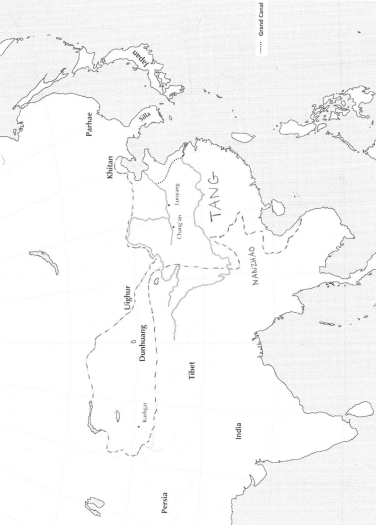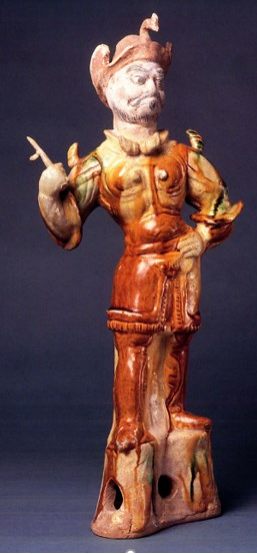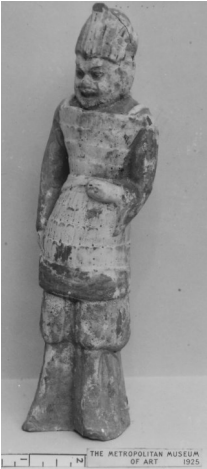7.4: The War Against Koguryŏ
- Page ID
- 135131
Sui’s reconquest of Han territory did not include its far western holdings. The Sui founder worried about the Turks to the West, and about the possibility of Koguryŏ allying with the Turks – just as Han Wudi had worried about Chosŏn and the Xiongnu. Koguryŏ did attack Sui, and Sui’s counterattacks were foiled three times by Koguryŏ official Ulchi Mondok. The war decimated the Sui army, bankrupted the Sui regime, and destroyed its popular support in its northern base. When the second Sui emperor was assassinated, Sui general Li Yuan eliminated his rivals through war, to found the Tang dynasty in 618. (His generals included his daughter, the Pingyang princess, leading an army she herself had raised.) In effect, Koguryŏ had ended the Sui dynasty.


Tang quickly incorporated the far west of former Han territory. But to the east things were more complicated. In the middle of the sixth century, the Korean Three Kingdoms were struggling with one another. Silla, with Yamato military aid, had taken considerable territory from Koguryŏ and Paekche. Paekche in its turn allied with Yamato, and struck back at Silla. Now, in the seventh century, Silla appealed for aid to Koguryŏ and Yamato in vain, and finally turned to Tang. To signify eagerness for Tang aid, Silla Queen Sŏndok (r. 632-647) adopted Tang-style court dress, official titles, and reign-names for its calendars. Beginning in 640, she sent members of the Silla royal family to join the thousands of students from Paekche, Koguryŏ, Tibet, Turfan, and elsewhere who had flocked to the Tang academy set up in 631. The Tang welcomed such prestige-giving moves, for it was not yet secure. The diplomacy also included passing a Silla monk, Chajang (590–658), back and forth with scriptures, relics, and images.
With Silla and Tang allied, Koguryŏ aristocrats saw trouble coming. They allowed one of their number to seize and centralize power, to prepare a defense.
Confidently, Tang Taizong (r. 626-649) proclaimed his right and duty to rule the whole world. He personally led troops against Koguryŏ in 645, behaving with great brutality: he buried alive three thousand Malgal (Mohe) warriors fighting for Koguryŏ. Taizong expected to march the royal family of Koguryŏ triumphantly across the northeast and through the streets of Chang’an. Instead, he lost badly; even forts initially he captured were retaken by Koguryŏ. The defeat was so humiliating that historian Andrew Eisenberg calls him “an emperor on the run” as he tried to reclaim his reputation and hold onto power. Some courtiers accused him of having a “Han Wudi complex” – as in, “My empire has to be bigger than his!” “Hemorrhaging prestige and political capital,” in Eisenberg’s words, Taizong retreated for a month to Bingzhou, the old home of the Li family. While there he wrote a stone inscription for a famous old shrine to spirits including a very ancient female water deity and a Zhou king. The inscription recounts the history of the dynasty so far (as Changsu’s stele for his father Kwanggaet’o had done in 414), emphasizing that – unlike Sui – Tang did not covet wealth and power and territory for its own sake, but wanted to rule for the sake of the people. In other words, “Oh well, I didn’t really want Koguryŏ’s territory anyway.”10 – Fortunately for Taizong, Tang armies won some great victories to the West, and he was able to retrieve his military reputation at gathering of many western tribal leaders who acknowledged his overlordship as “Heavenly Khaghan.”11 Taizong left famous instructions to his sons, saying that military offensives should be balanced with the good of the people: this is a position that Koguryŏ forced him into.
Fifteen years later, in 660, Tang had a bit more success to the east. Tang Gaozong and his Empress Wu allied with Silla King Taejong Muyŏl and his successor. Together the two armies demolished the kingdom of Paekche in the first mainland military victory in Korea since Han times. Silla incorporated Paekche’s territory in 660. The Silla-Tang alliance finally managed to take advantage of internal fighting in Koguryŏ to defeat it in 668.
That done, Tang renounced its ally. It turned on Silla, trying to conquer the whole peninsula and Manchuria. But by 676, Silla armies that included the soldiers of its former rival kingdoms Paekche and Koguryŏ had expelled Tang from the whole peninsula, for good. Tang and Silla two resumed diplomatic relations. Silla sent frequent embassies to Chang’an, students and monks studied there, and a lively trade brought Tang luxury goods to the Silla court. But Tang never even got a toehold on the peninsula.
Koguryŏ King Kwanggaet’o, back in the late fourth century, had not fulfilled all of his military ambitions. But kingdom shaped East Asian politics right up to its end in 668, and played a definitive role in keeping the very powerful Sui and Tang empire off the peninsula. Ulchi Mondok brought down the Sui, defeats by Koguryŏ destabilized the early Tang, and Koguryŏ soldiers under Silla chased Tang out of the peninsula. Tang did hold the Manchurian part of Koguryŏ’s territory, but only for three decades. Then old Koguryŏ aristocrats and members of the Malgal (Mohe) tribe rebelled against Tang. They founded the state of Parhae, which lasted in Manchuria and the Liaodong peninsula until 926. In a way, Kwanggaet’o’s dynasty lived on.




